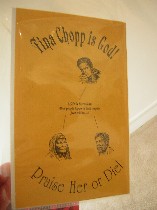 The show at Philadelphia University, “d.i.y. revolution,” crackles with the energy of the zines it has on display–home-made publications done for love and obsession and just the desire to get into print come hell or high water (the zine at the left proclaims, Tina Chopp is God! Praise Her or Die!).
The show at Philadelphia University, “d.i.y. revolution,” crackles with the energy of the zines it has on display–home-made publications done for love and obsession and just the desire to get into print come hell or high water (the zine at the left proclaims, Tina Chopp is God! Praise Her or Die!).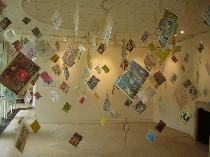 The show is crammed with zines that rain from the ceiling. After the gauntlet of words, images and paper, there are shelves with zines, a sofa for relaxing with zines, and shelves filled with related art forms–mail art and underground music recordings and covers–also mailable.
The show is crammed with zines that rain from the ceiling. After the gauntlet of words, images and paper, there are shelves with zines, a sofa for relaxing with zines, and shelves filled with related art forms–mail art and underground music recordings and covers–also mailable.
carton, sean
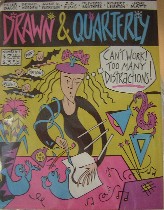 Curated by Philadelphia University Dean Sean Carton and writer Gareth Branwyn, and culled from the collections of Branwyn and Scott Huffines of Atomic Books, the exhibit is lots of fun–for lovers of words, images and culture. It’s an explosion of creativity, unedited by the powers that be in publishing or in art and relieved of the imperative of financial gain.
Curated by Philadelphia University Dean Sean Carton and writer Gareth Branwyn, and culled from the collections of Branwyn and Scott Huffines of Atomic Books, the exhibit is lots of fun–for lovers of words, images and culture. It’s an explosion of creativity, unedited by the powers that be in publishing or in art and relieved of the imperative of financial gain.
 What struck me, as I worked my way through, were the relationships between zine graphics and the whole cartoony art scene that we’re now wallowing in. There’s the same kind of “bad design,” that’s so bad it’s good. There’s the same kind of straightforward narrative use of imagery. There’s the goofiness and quirkiness–things we now accept as normal, but which are clearly outgrowths of an outsider approach. I’m thinking here of the work by artists like Jim Houser (now at Spector Gallery) and Jason Sho Green (at Art Star); I’m also thinking of the wheat-paste brigade and the whole Space 1026 gallery scene.
What struck me, as I worked my way through, were the relationships between zine graphics and the whole cartoony art scene that we’re now wallowing in. There’s the same kind of “bad design,” that’s so bad it’s good. There’s the same kind of straightforward narrative use of imagery. There’s the goofiness and quirkiness–things we now accept as normal, but which are clearly outgrowths of an outsider approach. I’m thinking here of the work by artists like Jim Houser (now at Spector Gallery) and Jason Sho Green (at Art Star); I’m also thinking of the wheat-paste brigade and the whole Space 1026 gallery scene.
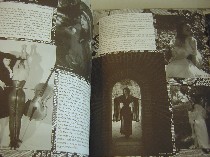 The main point of the show is that the computer and the program Pagemaker made desktop publishing a breeze, thereby fathering a publications revolution. The confluence of the two technologies suddenly enabled people with some obsession or love or other mission a cheap, quick method of production. If you write it or draw it you can print it too (left, a spread of Goth fashions from one of the zines; other favorite subjects for zines included “McJob,” “Full Frontal Nudity” and a number of how-to-do-it zines).
The main point of the show is that the computer and the program Pagemaker made desktop publishing a breeze, thereby fathering a publications revolution. The confluence of the two technologies suddenly enabled people with some obsession or love or other mission a cheap, quick method of production. If you write it or draw it you can print it too (left, a spread of Goth fashions from one of the zines; other favorite subjects for zines included “McJob,” “Full Frontal Nudity” and a number of how-to-do-it zines).
 The curators put zines in historical context of the invention of the printing press, as well as Ben Franklin’s broadsheets, Russian samizdat, and underground comics; and they credit zines with enabling the underground music scene and other underground, upstart cultural phenomena of the ’80s and ’90s. They also claim that zines were a conduit for affinity groups to find one another.
The curators put zines in historical context of the invention of the printing press, as well as Ben Franklin’s broadsheets, Russian samizdat, and underground comics; and they credit zines with enabling the underground music scene and other underground, upstart cultural phenomena of the ’80s and ’90s. They also claim that zines were a conduit for affinity groups to find one another.
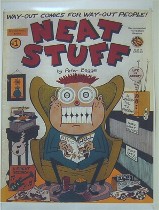 And as we all know, or at least Roberta and I know, blogging has taken over all of these roles. Internet publishing is even faster and cheaper and more easily distributed. The main drawback is our ability to reach those who aren’t Internet savvy or even who are disconnected. But it’s still a wide reach compared to hand-mailed and -distributed zines. Hence the decline in zine production.
And as we all know, or at least Roberta and I know, blogging has taken over all of these roles. Internet publishing is even faster and cheaper and more easily distributed. The main drawback is our ability to reach those who aren’t Internet savvy or even who are disconnected. But it’s still a wide reach compared to hand-mailed and -distributed zines. Hence the decline in zine production.
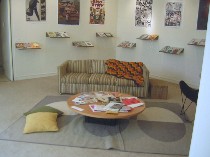 Anyway, leave some time to play around with this show and sit and read some of the offerings. There’s lots to see. At the zines peak, an estimated 20,000 were in existence according to the curators. The show feels like a nice chunk of that profusion is right in the room with the sofa. It’s a lot of fun (right, the cozy reading room).
Anyway, leave some time to play around with this show and sit and read some of the offerings. There’s lots to see. At the zines peak, an estimated 20,000 were in existence according to the curators. The show feels like a nice chunk of that profusion is right in the room with the sofa. It’s a lot of fun (right, the cozy reading room).









